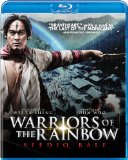| Reviews & Columns |
|
Reviews DVD TV on DVD Blu-ray 4K UHD International DVDs In Theaters Reviews by Studio Video Games Features Collector Series DVDs Easter Egg Database Interviews DVD Talk Radio Feature Articles Columns Anime Talk DVD Savant Horror DVDs The M.O.D. Squad Art House HD Talk Silent DVD
|
DVD Talk Forum |
|
|
| Resources |
|
DVD Price Search Customer Service #'s RCE Info Links |
|
Columns
|
|
|
Warriors of the Rainbow: Seediq Bale (Theatrical Cut)
Well Go USA // Unrated // August 7, 2012
List Price: $29.98 [Buy now and save at Amazon]
The Film:
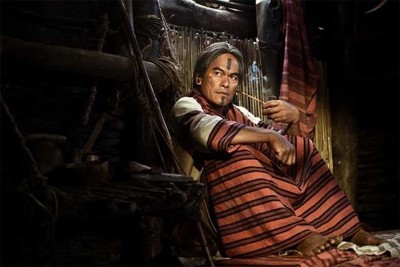 It'd be difficult to find a film where decapitations carry loftier emotional potency than they do in Warriors of the Rainbow: Seediq Bale, the John Woo-produced historical epic that earned the label of Taiwan's most expensive production to date. Wei Te-Sheng's brutal, enthralling vision of the Wushe Rebellion of the early-'30s recalls the last major push against Japanese forces during the mandatory assimilation of Taiwan's indigenous people, where wars are fought amongst rival sub-tribes and against "civilized" invading outsiders employing modernized tactics. Primitive, guerilla-style warfare through Taiwan's forested corners might seem like an unusual vessel for a comparatively rich budget; yet, the full breadth of those resources can be seen in its enlivening battles and attention to detail, which bring a significant occurrence in Taiwan's history to the screen in captivating fashion. And when heads (and lives) are taken in ceremonious coming-of-age displays, it's hard to resist feeling equal parts unsettled and celebratory.
It'd be difficult to find a film where decapitations carry loftier emotional potency than they do in Warriors of the Rainbow: Seediq Bale, the John Woo-produced historical epic that earned the label of Taiwan's most expensive production to date. Wei Te-Sheng's brutal, enthralling vision of the Wushe Rebellion of the early-'30s recalls the last major push against Japanese forces during the mandatory assimilation of Taiwan's indigenous people, where wars are fought amongst rival sub-tribes and against "civilized" invading outsiders employing modernized tactics. Primitive, guerilla-style warfare through Taiwan's forested corners might seem like an unusual vessel for a comparatively rich budget; yet, the full breadth of those resources can be seen in its enlivening battles and attention to detail, which bring a significant occurrence in Taiwan's history to the screen in captivating fashion. And when heads (and lives) are taken in ceremonious coming-of-age displays, it's hard to resist feeling equal parts unsettled and celebratory.
Comparisons made to Braveheart and The Last of the Mohicans are more than accurate, though, to a point that extends beyond the bubble of mere influence. Warriors of the Rainbow exploits matching notes of tribal conflict, rash motivations, and freedom from domineering oppressors to punctuate the tale of Mona Rudao and his sleeping-giant revolt against the Japanese, yet it starts twenty-years prior in the chieftain's youth, establishing a foundation to the Seediq Bale's way of life. First depicting Mona Rudao as a youthful, newly-crowned leader of a section of the Seediq Bale as a way of revealing the tribe's healthier years, it emphasizes how a boy doesn't become a man -- and doesn't earn his distinctive facial tattoo -- until he claims the head of one of his enemies, giving us a foundation for their proud native roots. We absorb their way of life before the Japanese occupy the land; they hunt, they trade, and they marry, aiming to glorify themselves in the eyes of their gods until they gain entry into the world beyond the rainbow.
Wei Te-Sheng's nimble perspective glides through the Taiwanese forests and villages not unlike that of Dante Spinotti's work in Mohicans, establishing the geography of the Seediq Bale's sprawl of wooded land. Lush greens dominate the image; towering trees and flourishing vegetation provide visually intriguing pathways for the tribesmen to sprint,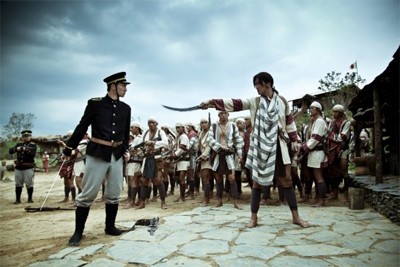 hide in, and exploit while on the hunt (or in battle). Warriors of the Rainbow understands where the audience's base pleasures reside, and sequences involving this constant movement will make those looking upon it appreciative of both the complexity and earthen beauty in those vigorous sprints through the forests. Wei Te-Sheng also understands the import within the quiet moments that bookend the forest action, composed in resolute angles that accentuate the emotion behind preserving their heritage -- both in conversations and forceful emblematic visuals, such as a tribesman lying atop the skulls of the heads he's claimed.
hide in, and exploit while on the hunt (or in battle). Warriors of the Rainbow understands where the audience's base pleasures reside, and sequences involving this constant movement will make those looking upon it appreciative of both the complexity and earthen beauty in those vigorous sprints through the forests. Wei Te-Sheng also understands the import within the quiet moments that bookend the forest action, composed in resolute angles that accentuate the emotion behind preserving their heritage -- both in conversations and forceful emblematic visuals, such as a tribesman lying atop the skulls of the heads he's claimed.
Then, the Japanese violently occupy and colonize this self-contained Seediq Bale's village, which leads to a twenty-year leap in time -- and to the bread-'n-butter of the film's purposes -- to showcase how forced civilization has constrained their heritage. Once-proud tribesman have been bridled by taking on low-wage logging jobs under the Japanese employ, drinking themselves into a submissive stupor to forget their past freedom, and kowtowing to the threatening presence of their occupiers, all with very little choice in the matter. Mona Rudao himself, now considered something of a powerless "chief", watered himself down to this level as well, even though we see that he's scheming under the nose of the Japanese. The script capably navigates between historical points with a cinematic focus on its varied characters and their reactions, as sympathetic performances from a mostly unknown cast form a mosaic of ways the Seediq Bale mold and transform under oppression: some adapt, some assimilate, some stagnate, and others wait.
Even those with no knowledge of the Wushe Incident will realize a revolt's brewing in the tribesman's anguish, but Wei Te-Sheng gives Warriors of the Rainbow its own tenacity, overcoming what's anticipated with purpose-driven brutality -- especially in the decapitations -- and a firm grasp on the Seediq Bale 's legacy. Bloody, spirited skirmishes spread across the Taiwanese forests once events push them beyond that anticipated threshold; hand-to-hand fights aren't frequent, but the close-quartered battles involving bows-'n-arrows and rifles achieve a similarly tense, erratic manner that spreads across the second half of the film. They're poignant fights too, with historical resonance and immediacy fueling them, where location and circumstance shape the scenes' veracity. Full-fledged battles in the woods offer an advantage to the native Seediq Bale, while warring with the Japanese in the villages -with some of their kind dressed in Japanese kimonos and civilian clothes -- creates grim anxiety over the outcome. And this isn't a piece of work afraid of killing off those caught in the conflict, either.
The surprising thing about Warriors of the Rainbow is that it steers relatively clear of being too heavy-handed in its messages of antiquated freedom, political climate change, and belief in the afterlife, something even the staunchest of historical epics have fallen prey to. In the build-up to the final act, replete with gas bombs, children manning machine guns, and gallivanting towards near-impossible odds, Wei Te-Sheng's vision maintains a moral perspective that doesn't fully topple its balance to the side of the Seediq Bale and Mona Rudao's uprising. Sure, the film's entire point rests behind the unjust conquering and demoralization of these people, but their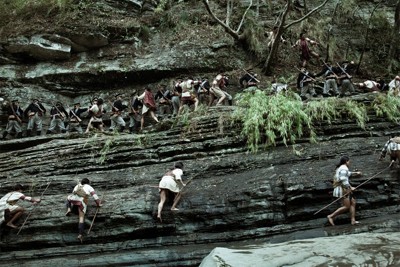 idealism doesn't come without prices to pay for impulsive decisions, and it's not afraid to reveal that happiness can happen under civilization. A gray area exists there, seen as Mona Rudao walks the length of a war-torn village with furious eyes following his movement. Alas, there's one scene that involves broad ritualistic suicide which, no matter if it's historically accurate or not, displays forced, objectionable expression in an unsettling depiction, a forgivable but pushy maneuver to gut-punch our empathy.
idealism doesn't come without prices to pay for impulsive decisions, and it's not afraid to reveal that happiness can happen under civilization. A gray area exists there, seen as Mona Rudao walks the length of a war-torn village with furious eyes following his movement. Alas, there's one scene that involves broad ritualistic suicide which, no matter if it's historically accurate or not, displays forced, objectionable expression in an unsettling depiction, a forgivable but pushy maneuver to gut-punch our empathy.
But, man, does it known how to end on a cathartic note. The home stretch of Warriors of the Rainbow reveals the thumbprint that John Woo left on the production, gallantly sprinting through explosions and fisticuffs in the Taiwanese forests in a rush of steadfast valor. Flames billow and mortars soar in true war-film fashion, pivoting on story's historical immediacy as the clash with the Japanese -- and the rival Seediq Bales -- reaches those pertinent boiling points that the story so pointedly alludes to from the start of the Japanese occupation. There's inevitability present in the last moments, however, a collision of William Wallace's final stand, Hawkeye's sprint through the American woods, a bit of Nathan Algren's enervation in The Last Samurai and, yes, hearty dashes of Red Cliff for good measure. Yet, while Wei Te-Sheng's production might ride on the coattails of formula, the tattooed faces of the Seediq Bale, and what they signify, elevate the borrowed framework into something more emotionally commanding than one might expect.
Different Cuts of Warriors of the Rainbow:
The version of Warriors of the Rainbow being covered here is the 150-minute internationally-distributed cut of the film, which differs from the four-and-a-half cut that originally played in Taiwanese theaters. Some might turn a cold shoulder to a chopped-down version of the story, but this cut actually competed on the short list for Best Foreign Language nominees at the 2011 Academy Awards. There's nothing empty or choppy about this pared-down iteration of the film; it lingers where it needs to, expertly shifts between sequences, and, to be honest, doesn't appear as if any material was even removed from its length. With a little deduction and thought put into it, sure, you could pinpoint most of the areas where the cut material would flesh out periphery characters and scenarios; however, no material feels skimped, rushed, or lacking in contextual perspective here, and it's highly probable that the leaner focus might actually service the core themes more fluently. In short, this isn't like Red Cliff or The Warlords, both emptier broken-down variations of their stories. Though, if one were inclined, Well Go USA have also offered the two-part Extended Cut on Blu-ray alongside the shorter international cut.
The Blu-ray:
Video and Audio:
Warriors of the Rainbow treks onto Blu-ray from in a 2.35:1-framed, 1080p offering from Well Go USA, which should stand out as the go-to disc if you're looking to display the many, many shades of green that exist in the wilderness. Sure, other palette choices peer out from the vegetation; terra-cotta skin tones, robust licks and billows of flames, and the low-color moments during dour sequences in the Japanese villages strike that point home, accentuated by numerous instances of alluring natural textures and contrast gradation, with nary a pixel out of place or an unnatural shift in movement. Only intermittently are they held back by over-processed shudders, some grayish-green black levels, and smeared details in the dense foliage, flaws which . But the mammoth success at-work here comes in the lively, full-bodied presentation of the Taiwanese forest's lush emerald-and-jade palette, painting a picture of the Seediq Bale's homeland that's sumptuous in the context of richly-composed, earthen photography. The film wants you to appreciate the unsullied, natural beauty of the world, and this HD transfer flourishes while doing so.
The 5-channel DTS-HD Master Audio track keeps its pace alongside the excellent visual transfer by landing frequent aggressive sound elements, from brash explosions to the firing of rifles and zip of arrows through the air. Occasionally, the dialogue limply goes along with the flow of the ambience, coming across as audible yet hollow and indistinct in the sprawled sound design. Graceful ambient elements make up for those shortcomings; trickling water in a brook, the rustling of leaves in the forest, and the patter of rainfall creates a fairly dynamic surround environment, hearty with surround activity where it's possible When the film's raw, loud ferocity gets going though, the track really thunders, flexing its war-film muscle in the thick of clanging, chaotic battle on more than a few occasions. Near-perfect subtitles, barring a missed word here and an omitted letter there, adorn the bottom of the image in clear yellow text, which can be paired with the sole HD audio track (and a 2-channel legacy offering).
Special Features:
Don't be fooled by the categories available in the special features though, because the Making-of (28:50, HD) option actually bleeds the three supplements available -- Making-Of, Behind the Scenes, Make-Up and Visual Effects -- into one mediocre thirty-minute stretch. Wei Te-Sheng discusses the original panel comics, while interviews with the filmmakers (including John Woo) guide us through expected topics. The filmmakers emphasize that failures in crossing production hurdles are what led to the film's successes, and it's very thorough on its content. That is, until it halts and segues into the raw production footage and discussion about the make-up. The material gets the job done in terms of elucidating some essential information, but it's nothing too special.
Well go USA have also tossed in a Theatrical Trailer (2: 03, HD) and International Trailer (2: 05, HD) for good measure.
Final Thoughts:
Historical epic aficionados will find Warriors of the Rainbow: Seediq Bale both familiar and exhilarating, a convincing combination for this recount of Taiwan's last major rebellion against Japanese colonists in the '30s. Visceral, briskly-paced, and bolstered by its significance to the fate of the indigenous people, there's a wealth of thematic strength and action-film boisterousness that pushes Wei Te-Sheng's film beyond the threshold of being considered a perfunctory docu-drama. In fact, there's a lot that goes extremely well here, from persuasive performance of the Seediq Bale's warriors to the graceful movement through the Taiwanese forests. And once it starts moving, both in terms of drama and thrilling action, it only slows down when it really needs to punctuate the purpose behind watching them fight for their self-contained, self-determined freedom. Well Go USA's Blu-ray sports terrific audiovisual properties that make the HD disc the way to go, while a few special features keep the interest flowing for about a half hour after the film. Heartily Recommended.
Thomas Spurlin, Staff Reviewer -- DVDTalk Reviews | Personal Blog/Site
 It'd be difficult to find a film where decapitations carry loftier emotional potency than they do in Warriors of the Rainbow: Seediq Bale, the John Woo-produced historical epic that earned the label of Taiwan's most expensive production to date. Wei Te-Sheng's brutal, enthralling vision of the Wushe Rebellion of the early-'30s recalls the last major push against Japanese forces during the mandatory assimilation of Taiwan's indigenous people, where wars are fought amongst rival sub-tribes and against "civilized" invading outsiders employing modernized tactics. Primitive, guerilla-style warfare through Taiwan's forested corners might seem like an unusual vessel for a comparatively rich budget; yet, the full breadth of those resources can be seen in its enlivening battles and attention to detail, which bring a significant occurrence in Taiwan's history to the screen in captivating fashion. And when heads (and lives) are taken in ceremonious coming-of-age displays, it's hard to resist feeling equal parts unsettled and celebratory.
It'd be difficult to find a film where decapitations carry loftier emotional potency than they do in Warriors of the Rainbow: Seediq Bale, the John Woo-produced historical epic that earned the label of Taiwan's most expensive production to date. Wei Te-Sheng's brutal, enthralling vision of the Wushe Rebellion of the early-'30s recalls the last major push against Japanese forces during the mandatory assimilation of Taiwan's indigenous people, where wars are fought amongst rival sub-tribes and against "civilized" invading outsiders employing modernized tactics. Primitive, guerilla-style warfare through Taiwan's forested corners might seem like an unusual vessel for a comparatively rich budget; yet, the full breadth of those resources can be seen in its enlivening battles and attention to detail, which bring a significant occurrence in Taiwan's history to the screen in captivating fashion. And when heads (and lives) are taken in ceremonious coming-of-age displays, it's hard to resist feeling equal parts unsettled and celebratory. Comparisons made to Braveheart and The Last of the Mohicans are more than accurate, though, to a point that extends beyond the bubble of mere influence. Warriors of the Rainbow exploits matching notes of tribal conflict, rash motivations, and freedom from domineering oppressors to punctuate the tale of Mona Rudao and his sleeping-giant revolt against the Japanese, yet it starts twenty-years prior in the chieftain's youth, establishing a foundation to the Seediq Bale's way of life. First depicting Mona Rudao as a youthful, newly-crowned leader of a section of the Seediq Bale as a way of revealing the tribe's healthier years, it emphasizes how a boy doesn't become a man -- and doesn't earn his distinctive facial tattoo -- until he claims the head of one of his enemies, giving us a foundation for their proud native roots. We absorb their way of life before the Japanese occupy the land; they hunt, they trade, and they marry, aiming to glorify themselves in the eyes of their gods until they gain entry into the world beyond the rainbow.
Wei Te-Sheng's nimble perspective glides through the Taiwanese forests and villages not unlike that of Dante Spinotti's work in Mohicans, establishing the geography of the Seediq Bale's sprawl of wooded land. Lush greens dominate the image; towering trees and flourishing vegetation provide visually intriguing pathways for the tribesmen to sprint,
 hide in, and exploit while on the hunt (or in battle). Warriors of the Rainbow understands where the audience's base pleasures reside, and sequences involving this constant movement will make those looking upon it appreciative of both the complexity and earthen beauty in those vigorous sprints through the forests. Wei Te-Sheng also understands the import within the quiet moments that bookend the forest action, composed in resolute angles that accentuate the emotion behind preserving their heritage -- both in conversations and forceful emblematic visuals, such as a tribesman lying atop the skulls of the heads he's claimed.
hide in, and exploit while on the hunt (or in battle). Warriors of the Rainbow understands where the audience's base pleasures reside, and sequences involving this constant movement will make those looking upon it appreciative of both the complexity and earthen beauty in those vigorous sprints through the forests. Wei Te-Sheng also understands the import within the quiet moments that bookend the forest action, composed in resolute angles that accentuate the emotion behind preserving their heritage -- both in conversations and forceful emblematic visuals, such as a tribesman lying atop the skulls of the heads he's claimed. Then, the Japanese violently occupy and colonize this self-contained Seediq Bale's village, which leads to a twenty-year leap in time -- and to the bread-'n-butter of the film's purposes -- to showcase how forced civilization has constrained their heritage. Once-proud tribesman have been bridled by taking on low-wage logging jobs under the Japanese employ, drinking themselves into a submissive stupor to forget their past freedom, and kowtowing to the threatening presence of their occupiers, all with very little choice in the matter. Mona Rudao himself, now considered something of a powerless "chief", watered himself down to this level as well, even though we see that he's scheming under the nose of the Japanese. The script capably navigates between historical points with a cinematic focus on its varied characters and their reactions, as sympathetic performances from a mostly unknown cast form a mosaic of ways the Seediq Bale mold and transform under oppression: some adapt, some assimilate, some stagnate, and others wait.
Even those with no knowledge of the Wushe Incident will realize a revolt's brewing in the tribesman's anguish, but Wei Te-Sheng gives Warriors of the Rainbow its own tenacity, overcoming what's anticipated with purpose-driven brutality -- especially in the decapitations -- and a firm grasp on the Seediq Bale 's legacy. Bloody, spirited skirmishes spread across the Taiwanese forests once events push them beyond that anticipated threshold; hand-to-hand fights aren't frequent, but the close-quartered battles involving bows-'n-arrows and rifles achieve a similarly tense, erratic manner that spreads across the second half of the film. They're poignant fights too, with historical resonance and immediacy fueling them, where location and circumstance shape the scenes' veracity. Full-fledged battles in the woods offer an advantage to the native Seediq Bale, while warring with the Japanese in the villages -with some of their kind dressed in Japanese kimonos and civilian clothes -- creates grim anxiety over the outcome. And this isn't a piece of work afraid of killing off those caught in the conflict, either.
The surprising thing about Warriors of the Rainbow is that it steers relatively clear of being too heavy-handed in its messages of antiquated freedom, political climate change, and belief in the afterlife, something even the staunchest of historical epics have fallen prey to. In the build-up to the final act, replete with gas bombs, children manning machine guns, and gallivanting towards near-impossible odds, Wei Te-Sheng's vision maintains a moral perspective that doesn't fully topple its balance to the side of the Seediq Bale and Mona Rudao's uprising. Sure, the film's entire point rests behind the unjust conquering and demoralization of these people, but their
 idealism doesn't come without prices to pay for impulsive decisions, and it's not afraid to reveal that happiness can happen under civilization. A gray area exists there, seen as Mona Rudao walks the length of a war-torn village with furious eyes following his movement. Alas, there's one scene that involves broad ritualistic suicide which, no matter if it's historically accurate or not, displays forced, objectionable expression in an unsettling depiction, a forgivable but pushy maneuver to gut-punch our empathy.
idealism doesn't come without prices to pay for impulsive decisions, and it's not afraid to reveal that happiness can happen under civilization. A gray area exists there, seen as Mona Rudao walks the length of a war-torn village with furious eyes following his movement. Alas, there's one scene that involves broad ritualistic suicide which, no matter if it's historically accurate or not, displays forced, objectionable expression in an unsettling depiction, a forgivable but pushy maneuver to gut-punch our empathy. But, man, does it known how to end on a cathartic note. The home stretch of Warriors of the Rainbow reveals the thumbprint that John Woo left on the production, gallantly sprinting through explosions and fisticuffs in the Taiwanese forests in a rush of steadfast valor. Flames billow and mortars soar in true war-film fashion, pivoting on story's historical immediacy as the clash with the Japanese -- and the rival Seediq Bales -- reaches those pertinent boiling points that the story so pointedly alludes to from the start of the Japanese occupation. There's inevitability present in the last moments, however, a collision of William Wallace's final stand, Hawkeye's sprint through the American woods, a bit of Nathan Algren's enervation in The Last Samurai and, yes, hearty dashes of Red Cliff for good measure. Yet, while Wei Te-Sheng's production might ride on the coattails of formula, the tattooed faces of the Seediq Bale, and what they signify, elevate the borrowed framework into something more emotionally commanding than one might expect.
Different Cuts of Warriors of the Rainbow:
The version of Warriors of the Rainbow being covered here is the 150-minute internationally-distributed cut of the film, which differs from the four-and-a-half cut that originally played in Taiwanese theaters. Some might turn a cold shoulder to a chopped-down version of the story, but this cut actually competed on the short list for Best Foreign Language nominees at the 2011 Academy Awards. There's nothing empty or choppy about this pared-down iteration of the film; it lingers where it needs to, expertly shifts between sequences, and, to be honest, doesn't appear as if any material was even removed from its length. With a little deduction and thought put into it, sure, you could pinpoint most of the areas where the cut material would flesh out periphery characters and scenarios; however, no material feels skimped, rushed, or lacking in contextual perspective here, and it's highly probable that the leaner focus might actually service the core themes more fluently. In short, this isn't like Red Cliff or The Warlords, both emptier broken-down variations of their stories. Though, if one were inclined, Well Go USA have also offered the two-part Extended Cut on Blu-ray alongside the shorter international cut.
The Blu-ray:
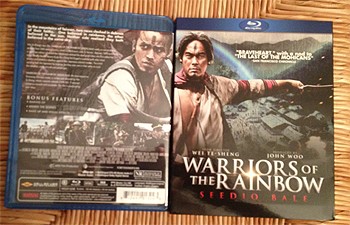 | 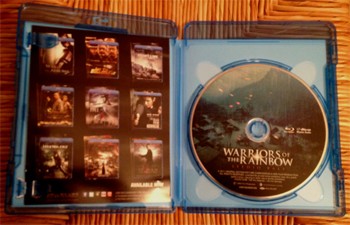 |
Video and Audio:
Warriors of the Rainbow treks onto Blu-ray from in a 2.35:1-framed, 1080p offering from Well Go USA, which should stand out as the go-to disc if you're looking to display the many, many shades of green that exist in the wilderness. Sure, other palette choices peer out from the vegetation; terra-cotta skin tones, robust licks and billows of flames, and the low-color moments during dour sequences in the Japanese villages strike that point home, accentuated by numerous instances of alluring natural textures and contrast gradation, with nary a pixel out of place or an unnatural shift in movement. Only intermittently are they held back by over-processed shudders, some grayish-green black levels, and smeared details in the dense foliage, flaws which . But the mammoth success at-work here comes in the lively, full-bodied presentation of the Taiwanese forest's lush emerald-and-jade palette, painting a picture of the Seediq Bale's homeland that's sumptuous in the context of richly-composed, earthen photography. The film wants you to appreciate the unsullied, natural beauty of the world, and this HD transfer flourishes while doing so.
The 5-channel DTS-HD Master Audio track keeps its pace alongside the excellent visual transfer by landing frequent aggressive sound elements, from brash explosions to the firing of rifles and zip of arrows through the air. Occasionally, the dialogue limply goes along with the flow of the ambience, coming across as audible yet hollow and indistinct in the sprawled sound design. Graceful ambient elements make up for those shortcomings; trickling water in a brook, the rustling of leaves in the forest, and the patter of rainfall creates a fairly dynamic surround environment, hearty with surround activity where it's possible When the film's raw, loud ferocity gets going though, the track really thunders, flexing its war-film muscle in the thick of clanging, chaotic battle on more than a few occasions. Near-perfect subtitles, barring a missed word here and an omitted letter there, adorn the bottom of the image in clear yellow text, which can be paired with the sole HD audio track (and a 2-channel legacy offering).
Special Features:
Don't be fooled by the categories available in the special features though, because the Making-of (28:50, HD) option actually bleeds the three supplements available -- Making-Of, Behind the Scenes, Make-Up and Visual Effects -- into one mediocre thirty-minute stretch. Wei Te-Sheng discusses the original panel comics, while interviews with the filmmakers (including John Woo) guide us through expected topics. The filmmakers emphasize that failures in crossing production hurdles are what led to the film's successes, and it's very thorough on its content. That is, until it halts and segues into the raw production footage and discussion about the make-up. The material gets the job done in terms of elucidating some essential information, but it's nothing too special.
Well go USA have also tossed in a Theatrical Trailer (2: 03, HD) and International Trailer (2: 05, HD) for good measure.
Final Thoughts:
Historical epic aficionados will find Warriors of the Rainbow: Seediq Bale both familiar and exhilarating, a convincing combination for this recount of Taiwan's last major rebellion against Japanese colonists in the '30s. Visceral, briskly-paced, and bolstered by its significance to the fate of the indigenous people, there's a wealth of thematic strength and action-film boisterousness that pushes Wei Te-Sheng's film beyond the threshold of being considered a perfunctory docu-drama. In fact, there's a lot that goes extremely well here, from persuasive performance of the Seediq Bale's warriors to the graceful movement through the Taiwanese forests. And once it starts moving, both in terms of drama and thrilling action, it only slows down when it really needs to punctuate the purpose behind watching them fight for their self-contained, self-determined freedom. Well Go USA's Blu-ray sports terrific audiovisual properties that make the HD disc the way to go, while a few special features keep the interest flowing for about a half hour after the film. Heartily Recommended.
|
| Popular Reviews |
| Sponsored Links |
|
|
| Sponsored Links |
|
|
| Release List | Reviews | Shop | Newsletter | Forum | DVD Giveaways | Blu-Ray | Advertise |
|
Copyright 2024 DVDTalk.com All Rights Reserved. Legal Info, Privacy Policy, Terms of Use,
Manage Preferences,
Your Privacy Choices | |||||||









